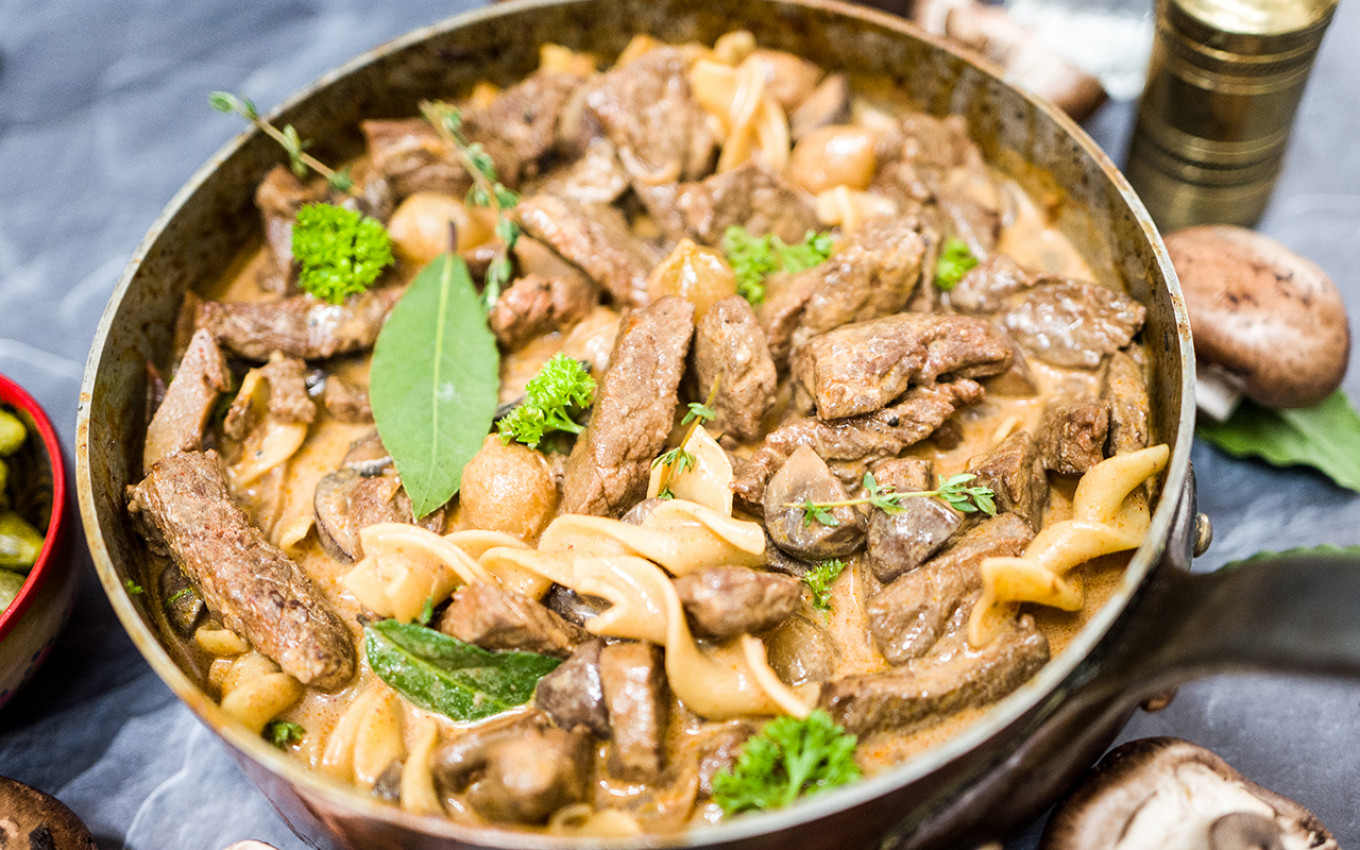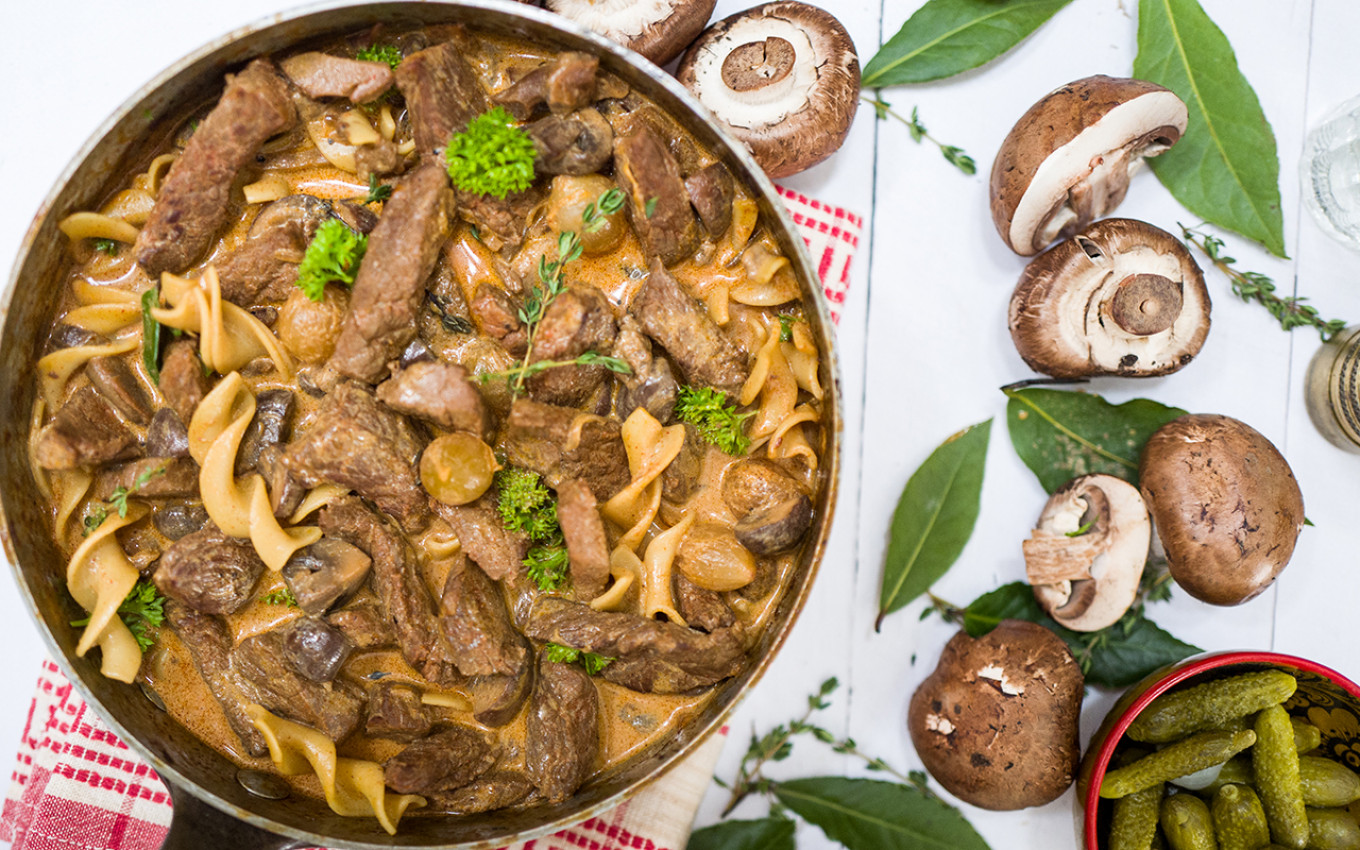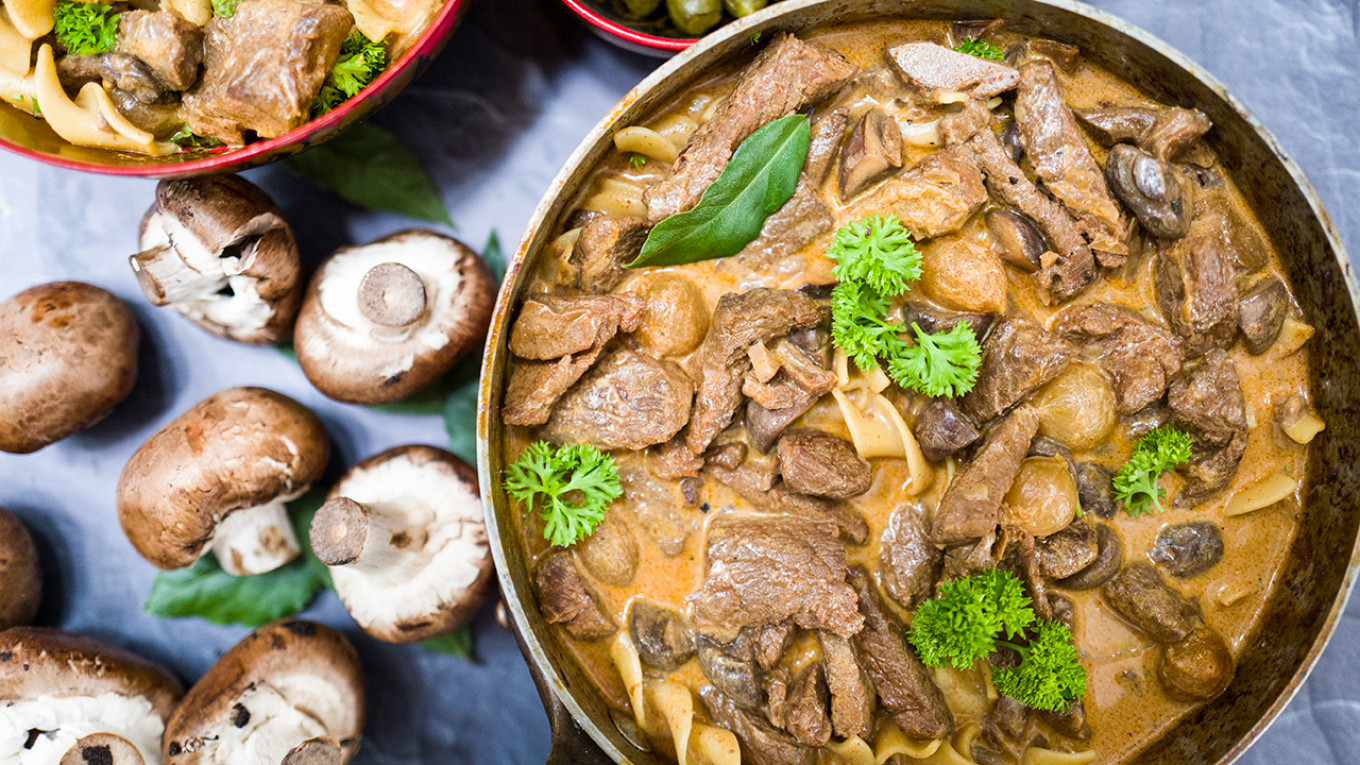One thing I never worry about is how to entertain out of town guests in Moscow. After twenty-some years, the template has been honed and refined into a delicate balance of classic rubbernecking (the Kremlin, Red Square, the Tretyakov Gallery, Novodeyvichy Convent and Cemetery) and just enough off-the-beaten-track experiences (Danilovsky Market, Garage, Izmailovo) to make them feel they’ve really gotten under the skin of the Big Potato. And I never hesitate when making reservations. I book a table at Café Pushkin and then, in true Russian fashion, I become authoritarian.
“You’ll have the Stroganoff,” I inform my guests, waving the dandy waiters and their enormously heavy menus away.
“Will we?” my guests sometimes timidly respond, but usually they are too footsore and “full of impressions” of Moscow to argue.
“You’ll thank me,” I say.
And they always do.
The Beef Stroganoff at Café Pushkin is all of the unapologetic excesses of Imperial Russia sautéed into one magnificent, rich, rib-sticking dish. I think of it as the culinary equivalent to Swan Lake at the Bolshoi or the Imperial Regalia at the Armory Chamber: impressive, satisfying, and solidly and so unequivocally Russian. And like a fur hat or a matryoshka doll, you really shouldn’t leave Moscow without it.
The Stroganoffs
Beef Stroganoff, like the family it was named for, has covered a great deal of ground. From the time of Ivan the Terrible, the Stroganoffs had a finely-honed taste for both adventure and the finer things in life. Pairing these passions, they successfully petitioned the Tsar for the rights to settle the virgin lands beyond the Urals. Becoming viceroys of Siberia, they controlled unimagined wealth in mineral ore, salt, fur, and timber. These riches kept them close to the throne even as it passed into the hands of the Romanovs. As the Romanovs introduced European culture to Russia, the Stroganoffs kept pace with their monarchs; they erected the elegant Stroganoff Palace on the Moika River in the new Imperial Capital of St. Petersburg, and staffed it with a regiment of servants, including the requisite French Chefs, without which no noble Russian household of the 17th Century was complete.
The Legends
Legends as to how a classic French fricassee de boeuf in cream sauce got its aristocratic name abound. Count Grigory Stroganoff (1770-1857), one story says, had terrible teeth and his French chef shaved cuts of beef into smaller-than-bite-sized morsels and mixed them with a rich cream sauce to help them go down smoothly.
Count Grigory’s son Alexander Stroganoff, one of Tsar Alexander III’s trusted ministers and a celebrated gourmand, employed a French chef Charles Brière who submitted a recipe for “Beef Stroganoff” to the Russian "L’Art Culinaire in 1891," the year his aristocratic employer died. Brière may have garnered praise and claimed authorship of the recipe, but it is unlikely he invented it; a recipe for govjadina po-stroganovski s gorchitseju (Beef Stroganoff with mustard) appeared in the authoritative "Gift to Young Housewives" by Elena Molokhovets in 1861. This version was blander and far more Spartan than the dish we know today, relying only on allspice and a dollop of Sareptskaja mustard to season the beef and sour cream.
Beef Stroganoff Develops
Four decades later, Pelagia Alexandrova-Ignatieva added significant layers of both flavor and texture to Beef Stroganoff in her 1912 "Practical Guide of the Basics of Culinary Arts" with the addition of mushrooms, onions, and tomato sauce. She also inaugurated the custom of serving Beef Stroganoff with potato straws, which has remained the Russian norm.
It took a revolution to spice things up.
In 1917, Beef Stroganoff headed east to China with White Russian emigreés fleeing the Bolsheviks. There, over several decades it became a regional favorite, its piquancy enhanced by the addition of hotter spices and complementary umami flavors such as fish and soy sauce. The Chinese served Stroganoff over rice, and it was in this iteration that it enjoyed great popularity during World War II with visiting American servicemen. They brought Beef Stroganoff to the United States in the post-war era, which sadly coincided with the American mania for convenience foods. Although Beef Stroganoff was a popular upscale dinner party staple, it was also “dumbed down” with ingredients such as Campbell’s Cream of Mushroom Soup and Heinz ketchup. Is it any wonder that Esquire's "Handbook for Hosts" called Beef Stroganoff “A Good He-Man’s Dish?”
Bringing Beef Stroganoff Home
To bring all of these legacies together into a version that remains true to Beef Stroganoff’s French origins, Russian ingredients, and Asian embellishments, I have developed a recipe to make at home when my “he-man” craves upscale comfort food. This recipe aims to strike a balance of a rich, creamy sauce spiked with just enough of Beef Stroganoff’s Asian sojourn to keep interesting. Mushrooms play a central role, true to the Russian passion for fungi. Campbell’s and Heinz are firmly banished for more exciting flavors that Brière, Alexandrova-Ignatieva, and yes, even the pioneering Stroganoffs would applaud.
I use two non-traditional methods, which address two potential stumbling blocks to making a successful Stroganoff. To avoid tough and overdone beef, I marinate it first in Asian flavors, which begins the tenderization process that the quickest of sears and a long rest finish. I also employ Kenji Lopez-Alt’s excellent method of proofing gelatin in the stock before combining it with the sour cream. This prevents the sour cream from separating or curdling, ensuring a velvety smooth texture.
Since I am American, I cannot let go of the idea that Beef Stroganoff should be served with buttered egg noodles and I make no apology for their inclusion here, though potatoes or rice work equally well as the mandatory side starch. What is non-negotiable, however, are plenty of salty, briny pickles or cornichons to serve alongside the Beef Stroganoff for the full-on experience!
See? Told you you’d enjoy it.

Beef Stroganoff
Ingredients
1 kilogram of lean beef, cut into thin (5 cm) strips
For the Marinade
- 60 ml soy sauce
- 2 Tbsp Asian Fish sauce
- 125 ml red wine
- 60 ml good quality olive oil
- 1 shallot, thinly sliced
- 1 garlic clove, crushed
For the Sauce
- 240 ml beef stock
- 5 tsp unflavored gelatin
- 350 grams Baby Bella Mushrooms, cleaned and quartered
- 100 grams dried porcini mushrooms
- 350 ml Marsala wine (use a dry white wine if you can’t find Marsala) divided into 250 ml and 100 ml
- 250 grams yellow onion, roughly chopped or peeled pearl onions (I used frozen)
- 4 Tbsp unsalted butter, in 5 separate pats
- 3 Tbsp canola oil
- 2 Tbsp mild paprika
- 1 tsp Aleppo pepper
- 1 Tbsp salt
- 2 tsp fresh ground pepper
- 3 Tbsp Dijon mustard
- 1 Tbsp Worcestershire sauce
- 2 Tbsp soy sauce
- 1 tsp anchovy paste
- 2 Tbsp tomato paste
- Fresh thyme
- 1 bay leaf
- 300 ml of thick sour cream (buy the best quality you can find) plus more for garnish.
- Snipped chives to garnish
- 1 package of wide egg noodles such as Pennsylvania Dutch Noodles
- 1 large bunch of fresh parsley, finely minced
- French Cornichons to garnish
Instructions
Prepare the beef
- Whisk together the ingredients for the marinade in a non-reactive container or clean plastic zip lock. Add the beef and refrigerate for at least 2 hours, but better overnight.
- Allow the meat to come to room temperature, then pat it try with paper towels. Combine the paprika, Aleppo pepper, salt, and pepper in a large bowl, then toss the meat strips so coated with the spices.
- Heat 1 Tbsp of canola oil in a large skillet or Dutch Oven until it is shimmering. Sear the meat in one layer (work in batches to give the meat plenty of room to cook). Allow each surface to brown (about 1-2 minutes per side). Remove the meat to a plate or dish. Set aside. Return the pot to the stove.
Prepare the sauce
- Sprinkle the gelatin on the stock and stir to combine. Set aside.
- Place the dried mushrooms in a large non-reactive jug or bowl. Add 100 ml of the Marsala wine and top up with boiling water until you have approximately 250 ml of liquid. Press the dried mushrooms down with the back of a spoon so that they are submerged. Cover with a clean dish cloth and let sit for 45 minutes.
- Heat another 1 Tbsp of canola oil and 2 Tbsp of butter in the skillet over medium heat until bubbling. Add the fresh mushrooms and cook, frequently tossing, until they leach their liquid, absorb it again, and begin to brown. Add another 1 Tbsp of butter and the onions and continue to cook, stirring often until the onions have become limp and golden.
- Decant the dried mushrooms from their soaking liquid and add to the mushroom and onion mixture, stirring to combine. Strain the mushroom liquid through a fine-mesh sieve or layer of cheesecloth. Add 240 ml to the stock and gelatin mixture.
- Add the tomato paste and mustard to the mushroom mixture and toss until paste coats the solids (about 2 minutes). Add the anchovy paste and continue to toss for another 2 minutes. Add any drippings from the meat plate to the pot. Then add the soy sauce, Worcestershire sauce and stir to combine.
- When the mushrooms have absorbed all of the added liquid, turn up the heat slightly and add the remaining 250 ml of Marsala wine and the fresh thyme. Once the wine has come to a vigorous simmer, reduce the heat slightly and stir with a wooden spoon, taking care to dislodge anything delicious sticking to the bottom of the pan and incorporate into the mix. Continue cooking at a steady simmer until most of the liquid is absorbed.
- Add the beef stock and gelatin mixture to the pot and stir to combine (1 minute). Then set a colander over a large bowl and strain the solids from the liquids. Put the solids back into the pot and set aside. Place the sour cream into a large bowl, then slowly pour approximately 100 ml of liquid into the sour cream, whisking vigorously as you do. When the sour cream and liquid are fully incorporated, pour the remainder of the liquid into the sour cream in a slow but steady stream, continuing to whisk until everything is combined.
- Place the pot with the solids back on low heat and stir in the stock and sour cream mixture. Add the meat to the pot and stir gently to combine and heat through.
Prepare the Noodles
- Cook noodles according to package instructions minus 1 minute. Decant 250 ml of pasta water before draining the noodles and returning them to the pot. Add 1 Tbsp of butter. Gradually add several spoonfuls of the pasta water as you toss until the butter is incorporated and the noodles are glossy. Add the parsley and toss to combine.
- Serve the Beef Stroganoff over the noodles. Garnish with more parsley, snipped chives, and a few dollops of sour cream and serve alongside sour pickles or cornichons.
*Gelatin technique adapted from J. Kenji Lopez-Alt of Serious Eats.
Jennifer Eremeeva is a longtime expat who writes about cuisine, history and culture. Follow her on Twitter @JWEremeeva and Instagram @jennifereremeeva.

A Message from The Moscow Times:
Dear readers,
We are facing unprecedented challenges. Russia's Prosecutor General's Office has designated The Moscow Times as an "undesirable" organization, criminalizing our work and putting our staff at risk of prosecution. This follows our earlier unjust labeling as a "foreign agent."
These actions are direct attempts to silence independent journalism in Russia. The authorities claim our work "discredits the decisions of the Russian leadership." We see things differently: we strive to provide accurate, unbiased reporting on Russia.
We, the journalists of The Moscow Times, refuse to be silenced. But to continue our work, we need your help.
Your support, no matter how small, makes a world of difference. If you can, please support us monthly starting from just $2. It's quick to set up, and every contribution makes a significant impact.
By supporting The Moscow Times, you're defending open, independent journalism in the face of repression. Thank you for standing with us.
Remind me later.







